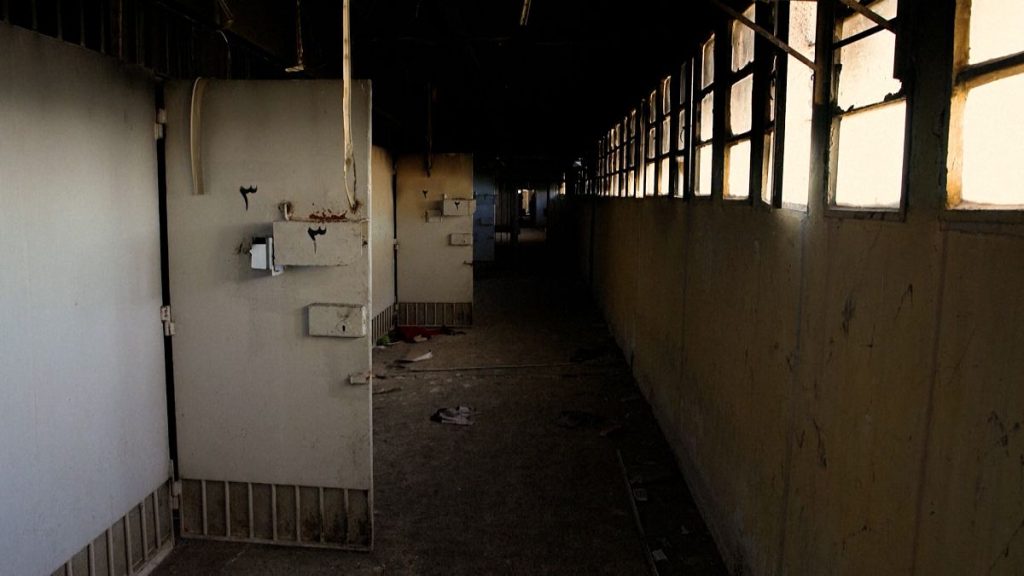Sayednaya Military Prison, a notorious detention facility located north of Damascus, Syria, stands as a chilling testament to the brutality and systematic human rights abuses perpetrated by the Assad regime during the ongoing Syrian conflict. For years, this clandestine prison has operated beyond the scrutiny of international observers, shrouded in secrecy and fear, becoming a symbol of the regime’s ruthless suppression of dissent. Within its heavily fortified walls, thousands of individuals, including political prisoners, activists, and those suspected of opposition to the government, have been subjected to unimaginable horrors, enduring torture, extrajudicial executions, and inhumane conditions. The Syrian lawyer, Lama Rifai, has undertaken the harrowing task of documenting the experiences of former inmates, meticulously collecting fragments of writing etched onto prison walls, scraps of paper, and any other available medium, piecing together a mosaic of suffering and resilience within Sayednaya’s oppressive confines.
The clandestine nature of Sayednaya’s operations has allowed the Assad regime to operate with impunity, perpetrating widespread human rights violations without accountability. Denied access to international humanitarian organizations and human rights monitors, the prison has become a black hole where individuals vanish, their fates unknown to the outside world. Former detainees who have survived the ordeal have provided chilling accounts of systematic torture, including beatings, electrocution, sexual assault, and mock executions. These testimonies, coupled with the documented evidence collected by individuals like Lama Rifai, paint a grim picture of a state-sanctioned system of torture and repression designed to crush any form of opposition and instill fear within the Syrian population. The lack of transparency surrounding Sayednaya has fueled concerns about the true scale of the atrocities committed within its walls, with estimates of deaths ranging from thousands to tens of thousands.
The writings left behind by former inmates, documented by Lama Rifai, serve as a poignant and powerful testament to the indomitable human spirit in the face of unimaginable suffering. These fragmented messages, often etched onto walls or hidden within personal belongings, offer glimpses into the lives, thoughts, and emotions of those imprisoned within Sayednaya’s walls. They speak of resilience, hope, and a desperate yearning for freedom, providing a stark contrast to the brutal reality of their existence. These writings also serve as a vital historical record, preserving the memories of those who perished within the prison and ensuring that their stories are not forgotten. Their collection and preservation represent an act of defiance against the regime’s attempts to erase the evidence of its crimes.
The United Nations and various human rights organizations have repeatedly condemned the Assad regime’s actions at Sayednaya and other detention centers across Syria, calling for independent investigations and accountability for the perpetrators of these atrocities. However, the regime’s refusal to cooperate with international inquiries and its continued denial of access to Sayednaya has hindered efforts to hold those responsible to account. The testimonies of former detainees, the documentation of prisoner writings, and satellite imagery analysis have all contributed to a growing body of evidence that implicates the Syrian government in systematic human rights abuses. The international community faces ongoing challenges in effectively addressing these violations and bringing justice to the victims and their families.
The situation at Sayednaya reflects a broader pattern of human rights violations in Syria, where the ongoing conflict has created a climate of impunity for government forces and other armed groups. The widespread use of torture, arbitrary detention, and enforced disappearances has become a hallmark of the Syrian conflict, leaving deep scars on the country’s social fabric and creating a legacy of trauma that will likely persist for generations. The international community’s efforts to address these human rights abuses have been hampered by political divisions and the complexity of the Syrian conflict, underscoring the urgent need for a comprehensive and coordinated international response to ensure accountability and protect the rights of the Syrian people.
The case of Sayednaya Military Prison serves as a stark reminder of the consequences of unchecked state power and the devastating impact of human rights abuses on individuals and societies. The continued existence of such facilities, operating outside the rule of law and beyond the reach of international scrutiny, underscores the fragility of international human rights mechanisms and the urgent need for greater international cooperation to prevent and address such atrocities. The stories emerging from Sayednaya, pieced together through the courageous efforts of individuals like Lama Rifai and the testimonies of survivors, must serve as a catalyst for action, prompting the international community to hold the Assad regime accountable for its crimes and work towards a future where such horrors are never repeated. The voices of those imprisoned within Sayednaya’s walls, echoing through their fragmented writings, demand to be heard and their suffering must not be forgotten.














